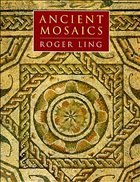Using thousands and sometimes millions of pieces of colored stone or glass to create elaborate patterns or scenes is a painstaking and expensive way to decorate a surface. Yet the art of mosaic enjoyed spectacular success in the Graeco-Roman world, where its practitioners created some of the most beautiful artworks in history. This handsomely illustrated and elegantly written book traces the evolution of mosaic from the Hellenistic period to the early Christian era, with particular emphasis on the Roman Empire, and examines its regional variations from Britain to North Africa and from the Levant to the Spanish seaboard.
The eminent classical scholar Roger Ling explains how mosaics were first made in the fifth century B.C. with the use of inset pebbles to provide durable pavements. He shows how mosaic became one of the hallmarks of luxury in Roman times, when such masterpieces of imperial floor decoration as the black-and-white silhouette pavements of Ostia and the colorful figure compositions of Piazza Armerina in Sicily were created. From pavements, mosaic graduated to walls and ceilings, where it culminated in the soaring blue and gold work of early Christian churches in Rome, Constantinople, and Ravenna. Ling examines the wide range of styles and subject matter employed by mosaicists, whether geometric patterns or figurative scenes of mythology, agriculture, and hunting, and explores what mosaics reveal about domestic and imperial tastes and aspirations. Such topics as techniques and materials, the relationship of mosaic to other forms of interior decoration, and the influence of ancient mosaics in more recent times are also discussed in detail.
Illuminating, attractive, and affordable, this book makes a major contribution to classical scholarship and will also appeal strongly to art historians, artists, designers, and general readers.
Table of contents:
1
Introduction
6
2
The Greek Period
19
3
Roman Italy
34
4
The Roman East
49
5
The Roman North-West
61
6
Roman Africa
77
7
Wall and Vault Mosaics
98
8
Context and Meaning
113
Map
136
Glossary
138
Select Bibliography
140
Illustration Acknowledgments
141
Index
142
The eminent classical scholar Roger Ling explains how mosaics were first made in the fifth century B.C. with the use of inset pebbles to provide durable pavements. He shows how mosaic became one of the hallmarks of luxury in Roman times, when such masterpieces of imperial floor decoration as the black-and-white silhouette pavements of Ostia and the colorful figure compositions of Piazza Armerina in Sicily were created. From pavements, mosaic graduated to walls and ceilings, where it culminated in the soaring blue and gold work of early Christian churches in Rome, Constantinople, and Ravenna. Ling examines the wide range of styles and subject matter employed by mosaicists, whether geometric patterns or figurative scenes of mythology, agriculture, and hunting, and explores what mosaics reveal about domestic and imperial tastes and aspirations. Such topics as techniques and materials, the relationship of mosaic to other forms of interior decoration, and the influence of ancient mosaics in more recent times are also discussed in detail.
Illuminating, attractive, and affordable, this book makes a major contribution to classical scholarship and will also appeal strongly to art historians, artists, designers, and general readers.
Table of contents:
1
Introduction
2
The Greek Period
3
Roman Italy
4
The Roman East
5
The Roman North-West
6
Roman Africa
7
Wall and Vault Mosaics
8
Context and Meaning
Map
Glossary
Select Bibliography
Illustration Acknowledgments
Index
Es gelten unsere Allgemeinen Geschäftsbedingungen: www.buecher.de/agb
Impressum
www.buecher.de ist ein Shop der
buecher.de GmbH & Co. KG
Bürgermeister-Wegele-Str. 12,
86167 Augsburg
Amtsgericht Augsburg HRA 13309
Persönlich haftender Gesellschafter: buecher.de Verwaltungs GmbH
Amtsgericht Augsburg HRB 16890
Vertretungsberechtigte:
Günter Hilger, Geschäftsführer
Christian Sailer, Geschäftsführer
Sitz der Gesellschaft:Augsburg
Ust-IdNr. DE 204210010
